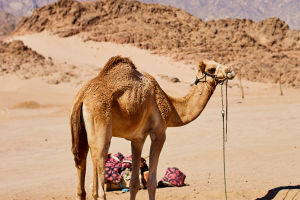The Sahara Desert is the world's largest hot desert, covering over 3.6 million square miles (9.4 million square kilometers) of land across the African continent. It stretches from the Atlantic Ocean in the west to the Red Sea in the east, and from the Mediterranean Sea in the north to the Sahel savannas in the south.
The desert is characterized by its hot and dry climate, with temperatures that can reach up to 136 degrees Fahrenheit (58 degrees Celsius) during the day and drop to freezing temperatures at night.
Despite the harsh conditions, the Sahara is home to a diverse range of plant and animal species that have adapted to survive in the extreme environment.
The desert's fauna includes the fennec fox, the sand cat, the scorpion, and the dromedary camel, which is commonly used by nomadic tribes for transportation and as a source of food and milk.
The Sahara's landscape is characterized by vast sand dunes, rocky plateaus, and dry riverbeds. The sand dunes, which can reach up to 600 feet (182 meters) in height, are constantly shifting due to the strong desert winds. The rocky plateaus, known as hamadas, are made up of hard, barren rock that is virtually devoid of vegetation.
The dry riverbeds, or wadis, are intermittent streams that only flow after heavy rainfall.
The Sahara's climate is influenced by the trade winds, which blow from the northeast and the southeast and create a dry and stable atmosphere over the desert. The lack of moisture in the air means that the Sahara receives very little rainfall, with some areas receiving less than 0.1 inches (2.5 millimeters) of precipitation per year. This makes the Sahara one of the driest places on Earth.
Despite the lack of rainfall, the Sahara is not entirely devoid of water. The desert's oases, which are areas of vegetation and water surrounded by arid land, have been vital to human settlement in the region for thousands of years.
The oases are usually located near underground water sources, such as aquifers or springs, and are home to a variety of crops, including date palms, figs, and olives.
The Sahara has been inhabited by humans for thousands of years, with evidence of human activity dating back to the Neolithic era. The ancient Egyptians traded with the inhabitants of the Sahara.
The Sahara has also played a significant role in the history of the African continent. The Trans-Saharan trade route, which connected West Africa to the Mediterranean world, was crucial to the development of the region's economy and culture. The trade route, which was used by caravans of camels, carried goods such as gold, ivory, salt, and slaves across the desert.
In addition to its historical significance, the Sahara is also of great scientific interest. The desert's extreme climate and isolated location make it an ideal location for studying the Earth's geological and climatological history. Researchers have used the Sahara's sand dunes to study wind patterns, and have found evidence of ancient human settlements buried beneath the sand.
The Sahara is also home to a number of unique geological formations, such as the Tassili n'Ajjer plateau in Algeria, which features stunning rock formations and prehistoric cave paintings. The region is also home to a number of rare and endangered species, including the Saharan cheetah and the addax antelope.


